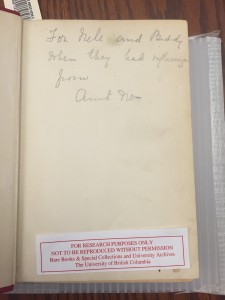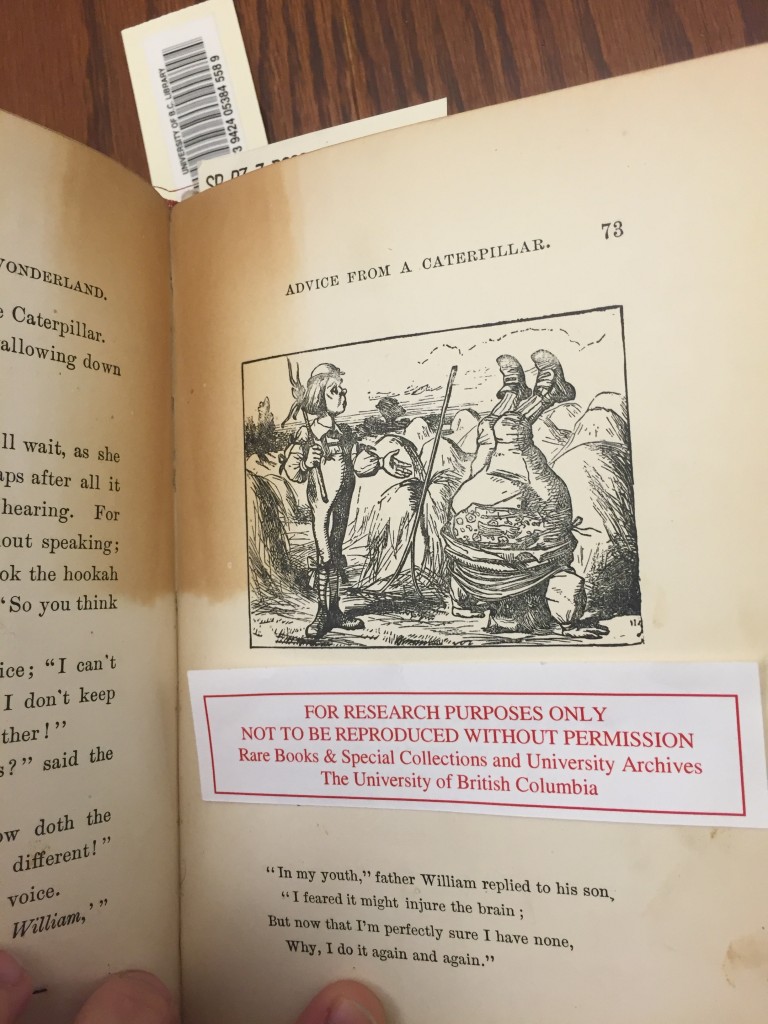The quirks, you say? Well, every book has quirks or things that distinguish that particular copy from others published by the same company. With our 1893 illustrated edition of Alice’s Adventures in Wonderland, there are three quirks I want to address (not because we were supposed to, but simply because I find them super

When they had influenza
From Aunt No”
interesting).
The first one is probably my favourite: a handwritten inscription in the front cover of the book. The inscription reads “For Nele and Buddy/ When they had influenza/ From, Aunt No”. While the content of the inscription may not be very exciting, the fact that there is actually any form of personalisation is incredible! Not because the inscribing of books with personalised messages was uncommon, but just because, for me, such an inscription actually grounds the book in a sort of reality. It actually belonged to someone. To someone who had a life, to someone who had a niece and nephew. While there is no actual way of dating when the inscription was written, my imagination has run wild with possibilities; my favourite being that the influenza talked about was the Spanish Flu of 1918 (not because I’m excited that the children possibly had the flu, but because it connects the inscription to a historical moment in time).
The second quirk I wanted to discuss was this poem that appears within the novel. It occurs after the title page and the table of contents, but it does not appear to be part of the beginning of the story either. My initial thought on reading this poem was that it was an addition added by the editor due to its abhorrent quality. I thought that the publisher might have wanted to try his hand at poetry and if he wrote a little introduction poem to Alice in Wonderland, it wouldn’t hurt anyone. However, as I looked into more and more editions of Alice published around the time of our edition, I found that that poem was also in those copies too (and they were published by different publishers). Therefore, I was forced to conclude that Lewis Carroll must have had an off day when he placed that poem as an introduction to his story (to read the poem, click here).
The last quirk I wanted to share was the stain. When I was looking through this copy of Alice, I noticed a brown stain on one of the pages. I inquired about it and our TA Bill told me that it was probably the result of

the acidification of the paper. Interestingly though, it wasn’t the acidification of the paper in our book. Bill suggested that someone had ended up leaving a bookmark of low quality paper within the book for years. Due to the low quality materials the bookmark was made with, it degraded and left a stain on the book. While it is a shame that the book was damaged in this way, we are able to tell that the paper in which this edition of Alice was printed on is of superb quality due to it not decaying greatly even when presented with an acidic material. This fact once again attests to the expensive price this book was originally purchased at.
While we were not required to include a section on our books “quirks”, I thought it was pertinent to do so, The reason why is because these individualisms are what I find so fascinating about old books. Yes, the history of their printing and the author’s biography are important points to know too, but the presence of these imperfections bring the book to life. They are, to me, what gives a book its history.
